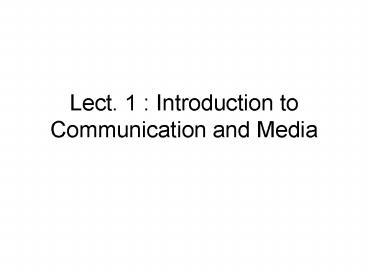Lect' 1 : Introduction to Communication and Media - PowerPoint PPT Presentation
1 / 13
Title:
Lect' 1 : Introduction to Communication and Media
Description:
Syntactic (formal properties of signs and symbols) ... or gestures, goes back to ancient cave paintings, drawn maps, and writing. ... – PowerPoint PPT presentation
Number of Views:18
Avg rating:3.0/5.0
Title: Lect' 1 : Introduction to Communication and Media
1
Lect. 1 Introduction to Communication and Media
2
- Communication - process that allows beings - in
particular humans - to exchange information by
one of several methods. - It requires symbols - languages -such as
- (i) speaking or singing, (ii) nonverbal, (iii)
physical means, such as body language, sign
language, touch or eye contact. - Level of Communication
- many levels (even for one single action), in
many different ways, and for all beings, and some
machines. - Dimensions
- Content (what type of things are communicated)
- Source (by whom)
- Form (in which form)
- Channel (through which medium)
- Destination/Receiver (to whom)
- Purpose/Pragmatic aspect (with what kind of
results)
3
- Communication as information transmission
- processes of information transmission governed
by three levels of semiotic rules - Syntactic (formal properties of signs and
symbols), - pragmatic (concerned with the relations between
signs/expressions and their users) and - semantic (study of relationships between signs
and symbols and what they represent). - Therefore, communication is a kind of social
interaction where at least two interacting agents
share a common set of signs and a common set of
semiotic rules. (This commonly held rule
essentially ignores autocommunication, including
intrapersonal communication via diaries or
self-talk).
4
- In a simplistic model, information or content
(e.g. a message in natural language) is sent in
some form (as spoken language) from a emissior
/sender/encoder to a destination/receiver/decoder.
In a slightly more complex form a sender and a
receiver are linked reciprocally.
5
- Forms of Communication
- Non-verbal
- Nonverbal communication - act or emotional
meaning . - Interchanging thoughts, opinions or information
without the use of words, using gestures sign
language, facial expressions and body language. - Language
- Language is a syntactically organized system of
signals, such as voice sounds, intonations or
pitch, gestures or , - written symbols which communicate thoughts or
feelings.
6
- Mass media
- Mass media is a very large audience (typically at
least as large as the whole population of a
nation state). mass society.
7
- Channels / Media
- The beginning of human communication through
artificial channels, i.e. not vocalization or
gestures, goes back to ancient cave paintings,
drawn maps, and writing. - Dominant communication medium divides history
into the following stages - (i) Ideographic writing produced the first
civilization alphabetic writing,
8
- The second printing,
- The third electronic recording and broadcasting,
- The fourth and computer communication,
- The fifth mobile devices, involves ad-hoc
organization through, allowing for effective
many-to-many communication and social networking
9
- Electronic media
- A revolution in telecommunications providing new
media for long distance communication. The first
transatlantic two-way radio broadcast occurred on
July 25, 1920 and led to common communication via
analogue and digital media - Analog telecommunications include traditional
telephony, radio, and TV broadcasts. - Digital telecommunications allow for
computer-mediated communication, telegraphy, and
computer networks.
10
- Communications media impact more than the reach
of messages. - Thomas Edison had to discover that hello was the
least ambiguous greeting by voice over a
distance previous greetings such as hail tended
to be garbled in the transmission. - Modern communication media now allow for intense
long-distance exchanges between larger numbers of
people (many-to-many communication via e-mail,
Internet forums). On the other hand, many
traditional broadcast media and mass media favor
one-to-many communication (television, cinema,
radio, newspaper, magazines).
11
- Media may refer to various aspects
- In communication
- Recording media, devices used to store
information - Print media, communications delivered via paper
or canvas - Electronic media, communications delivered via
electronic or electromechanical energy - Multimedia, communications that incorporate
multiple forms of information content and
processing - Hypermedia, media with hyperlinks
- Digital media, electronic media used to store,
transmit and receive digitized information
12
- Published media, any media made available to the
public - Mass media, all means of mass communication
- Broadcast media, communications delivered over
mass electronic communication networks - News media, mass media focused on communicating
news - News media (United States), the news media of the
United States of America - Media meshing, the act of combining of multiple
communication mediums to enrich an information
consumer's experience - New media, media that can only be created or used
with the aid of modern computer processing power
13
(No Transcript)

